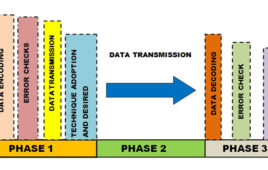Wireless Fidelity, more known by its short form Wi-Fi, is a digital communications protocol, through which gadgets can communicate with each other in [[wysiwyg_imageupload::]]a unicast or a broadcasting manner without using any wires. Being a wireless protocol, Wi-Fi standard uses the ISM (Industrial, Scientific and Medical) band of frequency which are free to use and require no licensing. Launched in 2.4GHz with transmission rates of 1-2mbps, Wi-Fi now works at 5GHz frequency also with astounding data transmission rates reaching upto 54mbps at both frequencies. Wi-Fi is a marketing term applied to 802.11b IEEE standard, but it now ubiquitously used for all the standards that fall under 802.11 category of Wireless LAN. So, Wi-Fi defines 802.11 x standards where x is the respective Wi-Fi version. Popular Wi-Fi version are a, b, g and n. The term “Wi-Fi” was added only to make the standard more common and rhyming with “hifi”, it was later that “wireless fidelity” took the full form of this term.
Internet : What is Internet
When the computing era took a major leap in the 80s, it was all just about the operating systems and the programming languages. People were getting gaga over the heavy technology revolution thinking that this is the one thing that the world needed to get over the bounds of time and space, and as usual, they were wrong. It was not long after the computer revolution that a tide, a blizzard of communication arrived. This technology now makes the computers look lifeless if they don’t have it. Connecting the corners of the cobwebbed world even from its remotest corner is the ‘Internet’. Not confining itself to any particular definition, the internet can be defined as the wired or wireless mode of communication through which one can receive, transmit information that can be used for single or multiple operations .
Raspberry Pi Based Digital Frame
Eternalizing memories by the way of taking pictures is one of the few old trends of the modern civilization whose origin cannot be tracked. Before the invention of cameras, memorizing people and incidents through paintings was a popular trend. Later on, with the cameras, we first came to the black and white clicks and then induced the RGB trend into them. When it came to keeping pictures as memory, photo frames did a good job for us. All we needed was to develop the camera roll and selecting out the image to be framed. With the advent of digital cameras, we took a giant leap from camera roll to the memory card. The prints became selective, but the photo frame stayed the same.
Internet : What is Internet
When the computing era took a major leap in the 80s, it was all just about the operating systems and the programming languages. People were getting gaga over the heavy technology revolution thinking that this is the one thing that the world needed to get over the bounds of time and space, and as usual, they were wrong. It was not long after the computer revolution that a tide, a blizzard of communication arrived. This technology now makes the computers look lifeless if they don’t have it. Connecting the corners of the cobwebbed world even from its remotest corner is the ‘Internet’. Not confining itself to any particular definition, the internet can be defined as the wired or wireless mode of communication through which one can receive, transmit information that can be used for single or multiple operations .
Wi-Fi Protocol: Networking, Frame Formats, Security, Attributes
Wireless Fidelity, more known by its short form Wi-Fi, is a digital communications protocol, through which gadgets can communicate with each other in [[wysiwyg_imageupload::]]a unicast or a broadcasting manner without using any wires. Being a wireless protocol, Wi-Fi standard uses the ISM (Industrial, Scientific and Medical) band of frequency which are free to use and require no licensing. Launched in 2.4GHz with transmission rates of 1-2mbps, Wi-Fi now works at 5GHz frequency also with astounding data transmission rates reaching upto 54mbps at both frequencies. Wi-Fi is a marketing term applied to 802.11b IEEE standard, but it now ubiquitously used for all the standards that fall under 802.11 category of Wireless LAN. So, Wi-Fi defines 802.11 x standards where x is the respective Wi-Fi version. Popular Wi-Fi version are a, b, g and n. The term “Wi-Fi” was added only to make the standard more common and rhyming with “hifi”, it was later that “wireless fidelity” took the full form of this term.





